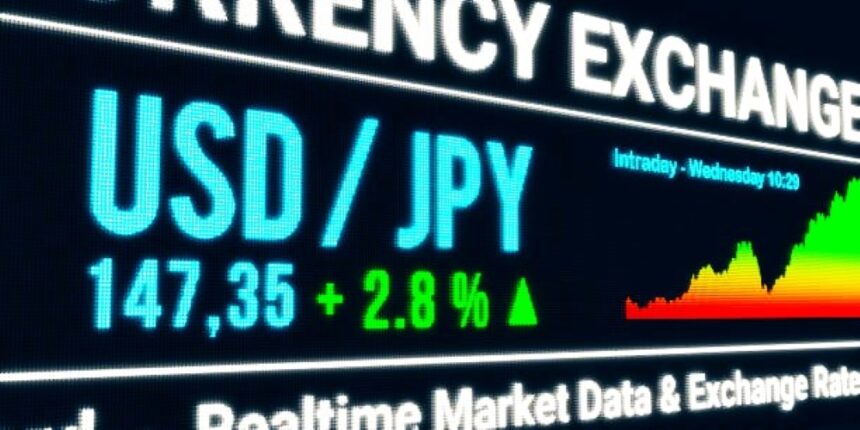Japanese Yen Surges Amid Trump New Tariffs Market Reactions and Future Outlook.
Japanese Yen (JPY) has strengthened significantly. This article explores the key factors driving the Yen’s movements, the economic implications, and what lies ahead for the currency and global markets. As the global financial markets have been shaken by the recent trade policy changes introduced by US President Donald Trump. The sweeping tariffs, which impose at least a 10% levy on all imported goods, have triggered a flight to safe-haven assets.
Japanese Yen Strengthens Amid Market Uncertainty.
The Japanese Yen is widely regarded as a safe-haven currency, meaning that investors tend to flock to it during times of global economic uncertainty. Following Trump’s tariff announcement, market sentiment soured rapidly, leading to increased demand for the Yen. This demand pushed the USDJPY pair down to a three-week low, settling around the 147.20-147.15 region during the Asian trading session.
Factors Behind the Yen’s Rally.
1. Flight to Safety:
Investors reacted to the uncertainty by pulling out of riskier assets, such as stocks, and moving their funds into traditional safe havens like the Yen, gold, and government bonds.
2. Weaker US Dollar:
The US Dollar weakened in response to fears that tariffs would slow economic growth, leading to expectations of Federal Reserve interest rate cuts.
3. US-Japan Interest Rate Differential:
The narrowing gap between interest rates in the U.S. and Japan further fueled Yen appreciation. Investors speculated that the Bank of Japan (BoJ) might raise interest rates while the Federal Reserve was expected to cut rates.
Economic Impact of Trump’s Tariffs
Global stock markets tumbled in response to the tariff announcement:
Japan’s Nikkei 225 fell over 3%.
South Korea’s Kospi dropped 1.5%.
Australia’s ASX 200 declined 1.9%, its worst single-day performance in months.
US Bond Yields Drop.
Investors seeking safe assets drove bond prices up, causing yields to fall. The yield on the benchmark 10-year U.S. government bond dropped to around 4.0%, a new low for the year.
Implications for Global Trade
1. Increased Trade Tensions:
The tariffs may escalate trade conflicts between the U.S. and major economies like China, Japan, and the European Union.
2. Impact on Japan’s Exports:
Japanese exporters, particularly in the automotive and technology sectors, face potential losses due to reduced demand and higher costs in the U.S. market.
Bank of Japan’s Policy Outlook.
Despite the Yen’s recent strength, the Bank of Japan remains cautious about its monetary policy. Key considerations include:
Inflation Trends: Strong consumer inflation data from Tokyo supports the case for rate hikes.
Trade Uncertainty: Concerns over the impact of tariffs on Japan’s economy may deter aggressive monetary tightening.
Federal Reserve’s Response
Market analysts are increasingly betting that the Federal Reserve will cut interest rates in response to economic slowdown concerns. Traders anticipate at least three 25-basis-point reductions before the end of the year.
Key Sectors Affected
Japanese Automotive Industry Under Pressure
The automotive sector, a cornerstone of Japan’s economy, is directly affected by the new tariffs. In 2024, Japanese automakers exported nearly 880,000 vehicles from Mexico to the U.S., with Nissan alone accounting for 327,000 units. With a 25% tariff on auto imports, these companies may struggle to remain competitive in the U.S. market.
Projected Impact:
Nissan’s profits could decline by over 50%.
Automakers may be forced to adjust supply chains or pass costs onto consumers.
Technology and Manufacturing Sectors
Electronics and semiconductor companies, which rely on U.S. supply chains and markets, may face disruptions due to increased trade barriers. These companies could see:
Higher component costs.
Reduced U.S. demand for Japanese products.
Potential shifts in production to avoid tariffs.
Investor Sentiment and Market Strategies
Amid market uncertainty, investors are employing several strategies:
Diversification: Allocating assets across multiple regions to reduce country-specific risk.
Hedging: Using financial instruments to protect against currency fluctuations.
Increasing Safe-Haven Holdings: Buying Yen, gold, and U.S. Treasuries to preserve capital.
Future Market Expectations
Investors and analysts will be closely watching:
US-Japan trade negotiations.
Economic data releases, such as U.S. jobless claims and ISM Services PMI.
Central bank policy announcements from both the Fed and the BoJ.
Long-Term Implications for the Yen and Global Markets
Scenario 1: Prolonged Trade War
If trade tensions persist, the Yen could continue appreciating as investors seek safety. This would create challenges for Japanese exporters but strengthen domestic purchasing power.
Scenario 2: Resolution and Market Recovery
If diplomatic negotiations lead to tariff rollbacks, global markets could stabilize. This scenario might weaken the Yen as investors return to riskier assets.
Conclusion
The Japanese Yen’s recent surge highlights the ongoing impact of global trade policies on financial markets. While the currency benefits from safe-haven demand, the broader economic implications for Japan remain uncertain. The narrowing US-Japan interest rate differential, central bank policies, and trade developments will continue to shape market movements in the coming months. Investors should stay informed and adopt strategic approaches to navigate this evolving landscape.
https://voiceoftraders.com/analysis/fundamental-analysis/gold-surges-to-a-record-3086








